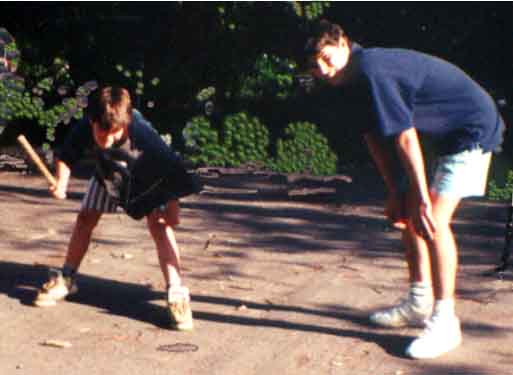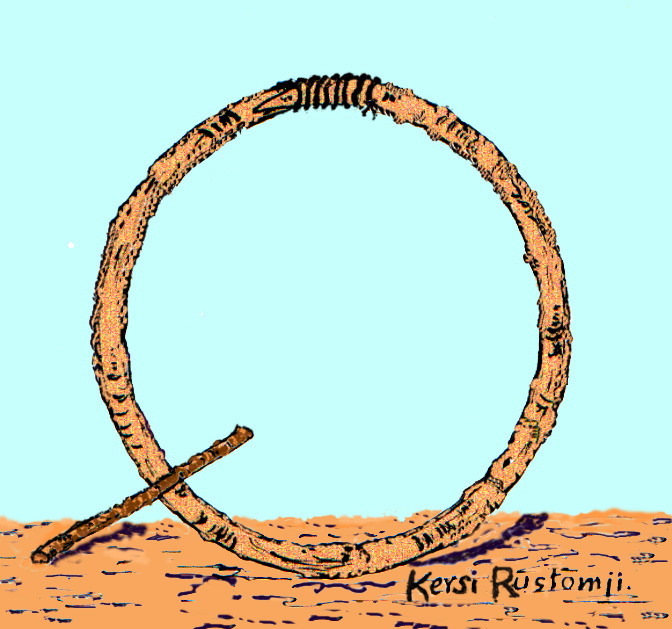4 Our Games
We played a variety of games according to the fad or seasons. Nobody seemed to know how or exactly when a change over from one to the other took place. One time kabadi would be in and suddenly a week or a fortnight later it would be nargel or goolli-danda. Apart from soccer and cricket most of our games had Indian origins yet others like marbles or rolling a hoop were pretty universal. Kite flying of course depended on the seasonal winds and the rainy season with its prevailing winds marked the start of it.
Kabadi, a team game was played on a court, which was very easy to prepare. All that was required was a bare patch of ground. Using a foot or a stick a large rectangle was marked out. The rectangle was divided into three parts. The two large ends comprised the court areas for each team; between this area was a narrow no-mans-land, wherein no member from either team could tag one another.
The purpose of the game was to enter the opponent’s area and tag as many members of their team which had not to exceed eleven. The tagged members were out and had to leave the court. However, the tagging part had to be done under a condition. The person tagging entered the opponents’ court and continually repeated the word, kabadi, and whoever he tagged was out. But if the opposition swamped him and prevented him from returning into the no-mans-land or his court, still uttering, kabadi, he was out and had to leave. In addition, if he ran out of breath and stopped uttering the kabadies before returning to the no-man’s-land or his own court, he was also out.
These games were very physical, the bouts lasted quite some time, and the team with the best score out of five bouts was the winner. These bouts were also held during local festivals and both adult and children’s teams participated, amid great shouts and spurring on of the favourite teams. A feast of sweetmeats and sherbets of various types followed these tournaments.
Goolli danda, I feel is to India what cricket is to England, yet it is the cheapest team sport I know of. The only equipment is readily picked up or made from any dead wood, dry branch or off-cuts from the local carpenter. Any open ground serves as a playing field. A piece of dried wood about four centimeters thick is used to make a short goolli and another, a danda, a striking stick. The danda is about half an arm’s length and the goolli is about ten centimeters long and round but it is whittled at the ends. When struck at either end it rises in air allowing the striker to hit it. Two players one on each side or a team of eleven or players each can play the game.
Having found a ground, a gabbi, a hole about the length of the goolli is hollowed out. The side winning the toss takes the strike while the other side spreads out in front of the hole to field. The batsman or the striker places the goolli across the hole and holding the danda behind it flings it as far as he can.The fielder, having stopped the goolli or from the spot where it has come to rest, throws it at the dunda over the hole. If he hits the dunda the striker is out and the next striker comes in. The striker is also out if during his push of the goolli he is caught.
If the striker is not out, he proceeds to the next stage, which is the scoring. He gets three chances to tap the goolli ends from where it has landed, and hit it as far as he can. At the end of the third strike, he has to estimate how many dandas distance the goolli is from the gabbi, the hole and quote a number. If the fielding team feels that the estimate is likely to be correct, they allow it. This then becomes the striker’s individual score and the team score. However, the fielding side has another option. If it feels that the estimate by the striker may fall short of the number quoted, they get the option to measure it.
Choosing the shortest line to the gabbi, the fielders measure the distance using the danda end over end. If it is short of the estimate quoted the striker is out. As the field has no limit, there are no boundaries. This is the simplest form of the game but there are also versions that are more advanced. Of course, the team with the highest score wins.
The game could last a long time depending on the team size and the number of innings agreed. Adults too played goolli danda, and then it was another town event not unlike a cricket match. The team supporters and punters thronged the maidan, the town open ground. Khan Saab brought his barrow of roasted nuts, chickpeas, corn pop, chana batata, spiced chickpeas with potatoes . Other vendors also sat up stalls of a variety of food, tea and soft drinks at the verges. A very lively day ensued, with the local band and a grand picnic.
 |
Michael & Paul try goolli dunda. The
gabbi, the hole, is in front of Michael’s left foot. He is about to strike with the danda, the goolli in front of his right foot. |
With the onset of the rainy season, the kites took over and everybody got busy making kites, as these could not be bought. Except for the crepe paper, we collected all the material, prepared or obtained from home or around town. Bamboo strips gathered from pieces at the seller or spines of the large dried coconut leaf fronds for the smaller kites formed the framework.
Glue was lye, prepared from corn flour and ash boiled together or we scrounged it from the town shoemaker. The string had to be bought which was number ten sewing cotton. Sometimes it was spirited from mum’s sewing box. All the flying was done at the maidan, open ground, near the lake close to the Chair Rock.
The sky filled with a variety of very colourful kites. White, blue, green, yellow and red colours dominated, with a long contrasting tail. The commonest shape was a diamond among us junior kids, while the bigger fellows had more elaborate designs. During the kite season some of us became off siders of the big fellows and did various chores like, cutting, trimming, preparing the flying strings and carrying all the gear. For this, the off sider was allowed the last half-hour to fly the large and elaborate kite. Some kids who had adult help also flew very large or elaborate kites. This, however, did not count the same as having made your own.
There were kite fights too in which kites dived across each other. Then with a rapid reeling in or letting off of the string one attempted to sever each other’s kite line. As soon as a kite line was severed there rose a shout of, cut, cut, and everybody raced to retrieve it and the first to do so kept it. These kite fights were very exciting, as it required a great skill to maneuver the kites into fighting positions and then execute various dives or dodges.
The adults too joined in on a special kite day and some of them were very serious and expert fliers. Manjo, very finely ground glass mixed with glue, coated the first ten meters or so of the string. As off siders we prepared and applied manjo to the string of our adult sponsers.This helped them to cut the string more rapidly during the fights, as well as the remaining manjo became ours. A great deal of betting took place among the onlookers and the kids were not allowed to fly on that day, but we could retrieve and keep the cut kites as trophies. At the end of the kite season, the town trees and some power lines became festooned with old torn kites hanging limply later torn into shreds by wind.
With the end of the rains, kites gave way to marbles or hoops, or perhaps hopscotch or nargel for one could never tell what was to come. Nargel was another team game, which required seven palm-sized stone and a tennis ball. The seven stones piled atop one another inside a small circle made a tiny pillar. Each member of the starting side had three attempts to strike down the pillar. As soon as it was knocked over, the striking team spread out. The fielding side then had to tag members of the striking team with the ball. The striking side was allowed to fend it off but only with their fists. In the course of all this some members of the striking side had to rebuild the pillar and when completed, shout nargel, which allowed the team another turn. However if a member of the striking team got ball-tagged by the fielding side, then the team was out and the sides changed play. It left a few swollen faces at the end of the day if one did not duck quickly enough at high tags, although the rule was to tag below the waist.
When hoops came in season, we made most of these from finger thick mulberry branches, which were easy to debark and loop. We whipped the loop ends with string and then weighed the loop down flat with stones or logs to dry without warping. Tapping with a small stick or spinning with a string attached to a stick we turned the hoops. The hoops accompanied the owners everywhere from shops to school or walks.
As soon as two or more hoop owners met, it became a race and challenges thrown about, whether on the way to school, home, and shop or wherever. The best races were at the end of school as a whole bunch started and had a great race amongst us as we could knock or nudge off the others’ hoops. If your hoop got knocked off it gave the others a lead, as you retrieved it and restarted. As we reached our homes, we dropped off, while the rest continued amid yells,whistles and curses. Everybody used the hoop as a pretend car and all the accompanying sounds of engines and horn and crashes were part of the race.
Some of the richer kids managed to obtain second-hand bicycle rims as their hoops. They were banned from such races as they had a great advantage in weight and strength over our mulberry hoops. They were, however allowed running along us as out riders.
A hoop and turning stick made from a mulberry branch.Some kids used old bicycle rims which was not considered fair game.
